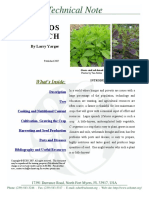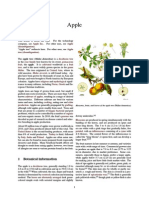Professional Documents
Culture Documents
Asparagus: Asparagus (Genus) Asparagus (Color)
Uploaded by
chetanpbhagatOriginal Description:
Original Title
Copyright
Available Formats
Share this document
Did you find this document useful?
Is this content inappropriate?
Report this DocumentCopyright:
Available Formats
Asparagus: Asparagus (Genus) Asparagus (Color)
Uploaded by
chetanpbhagatCopyright:
Available Formats
Asparagus
From Wikipedia, the free encyclopedia For the botanical genus, see Asparagus (genus). For the colour, see Asparagus (color). Asparagus officinalis
Wild asparagus in Austria
Scientific classification Kingdom: Plantae clade: Angiosperms clade: Monocots Order: Asparagales Family: Asparagaceae Subfamily: Asparagoideae Genus: Asparagus (genus) Species: A. officinalis Binomial name Asparagus officinalis
L.
Asparagus officinalis is a spring vegetable, a flowering perennial[1] plant species in the genus Asparagus. It was once classified in the lily family, like its Allium cousins, onions and garlic, but the Liliaceae have been split and the onion-like plants are now in the family Amaryllidaceae and asparagus in the Asparagaceae. Asparagus officinalis is native to most of Europe, northern Africa and western Asia,[2][3][4] and is widely cultivated as a vegetable crop.
Contents
[hide]
1 Biology
2 History 3 Uses o 3.1 Culinary 3.1.1 White asparagus in continental northwestern Europe o 3.2 Medicinal 4 Cultivation o 4.1 Companion planting 5 Commercial production o 5.1 Celebrations 6 Vernacular names and etymology 7 Urine effects o 7.1 Chemistry 8 Gallery 9 See also 10 Notes 11 References 12 External links
[edit] Biology
Asparagus shoot before becoming woody Asparagus is a herbaceous, perennial plant growing to 100150 centimetres (3959 in) tall, with stout stems with much-branched feathery foliage. The "leaves" are in fact needle-like cladodes (modified stems) in the axils of scale leaves; they are 632 millimetres (0.241.3 in) long and 1 millimetre (0.039 in) broad, and clustered 415 together. The root system is adventitious and the root type is fasciculated. The flowers are bell-shaped, greenish-white to yellowish, 4.56.5
millimetres (0.180.26 in) long, with six tepals partially fused together at the base; they are produced singly or in clusters of 23 in the junctions of the branchlets. It is usually dioecious, with male and female flowers on separate plants, but sometimes hermaphrodite flowers are found. The fruit is a small red berry 610 mm diameter, which is poisonous to humans.[5] Plants native to the western coasts of Europe (from northern Spain north to Ireland, Great Britain, and northwest Germany) are treated as Asparagus officinalis subsp. prostratus (Dumort.) Corb., distinguished by its low-growing, often prostrate stems growing to only 3070 centimetres (1228 in) high, and shorter cladodes 218 millimetres (0.0790.71 in) long.[2][6] It is treated as a distinct species, Asparagus prostratus Dumort, by some authors.[7][8] A remarkable adaptation is the edible asparagus, while in the Macaronesian Islands several species, (Asparagus umbellatus, Asparagus scoparius, etc.), are preserved the original form, a leafy vine; in the Mediterranean, the asparagus genus has evolved into thorny species.
[edit] History
Already about 20,000 years ago, asparagus was eaten near Aswan in Egypt. It has been used as a vegetable and medicine, owing to its delicate flavour, diuretic properties, and more. It is pictured as an offering on an Egyptian frieze dating to 3000 BC. Still in ancient times, it was known in Syria and in Spain. Greeks and Romans ate it fresh when in season and dried the vegetable for use in winter; Romans would even freeze it high in the Alps, for the Feast of Epicurius. Emperor Augustus reserved the Asparagus Fleet for hauling the vegetable, and coined the expression "faster than cooking asparagus" for quick action.[Note 1][9][10] There is a recipe for cooking asparagus in the oldest surviving book of recipes, Apiciuss third century AD De re coquinaria, Book III. Asparagus drew little medieval attention[11][Note 2] until al-Nafzawi's The Perfumed Garden celebrates its afrodisiacal power, which the Indian Ananga Ranga attributes to special phosporus elements that also counteract fatigue, and by 1469 it was cultivated in French monasteries. Asparagus appears to have been hardly noticed in England until 1538,[Note 2] and in Germany until 1542.[10] France's Louis XIV had special greenhouses built for growing it.[12] The finest texture and the strongest and yet delicate taste is in the tips, which points d'amour ("love tips") were served as a delicacy to Madame de Pompadour.[13] Asparagus became available to the New World around 1850, in the United States.[10]
[edit] Uses
[edit] Culinary
Asparagus
Nutritional value per 100 g (3.5 oz) Energy 85 kJ (20 kcal)
Carbohydrates - Sugars - Dietary fiber Fat Protein Thiamine (vit. B1) Riboflavin (vit. B2) Niacin (vit. B3) Pantothenic acid (B5) Vitamin B6 Folate (vit. B9) Vitamin C Vitamin E Vitamin K Calcium Iron Magnesium Manganese Phosphorus Potassium Zinc
3.88 g 1.88 g 2.1 g 0.12 g 2.20 g 0.143 mg (12%) 0.141 mg (12%) 0.978 mg (7%) 0.274 mg (5%) 0.091 mg (7%) 52 g (13%) 5.6 mg (7%) 1.1 mg (7%) 41.6 g (40%) 24 mg (2%) 2.14 mg (16%) 14 mg (4%) 0.2 mg (10%) 52 mg (7%) 202 mg (4%) 0.54 mg (6%)
Percentages are relative to US recommendations for adults.
Source: USDA Nutrient Database
Only young asparagus shoots are commonly eaten: once the buds start to open ("ferning out"), the shoots quickly turn woody.[14] Asparagus is low in calories [15] and is very low in sodium. It is a good source of vitamin B6, calcium, magnesium and zinc, and a very good source of dietary fiber, protein, vitamin A, vitamin C, vitamin E, vitamin K, thiamin, riboflavin, rutin, niacin, folic acid, iron, phosphorus, potassium, copper, manganese and selenium,[16][17] as well as chromium, a trace mineral that enhances the ability of insulin to transport glucose from the bloodstream into cells.[citation needed] The amino acid asparagine gets its name from asparagus, as the asparagus plant is rich in this compound.
The shoots are prepared and served in a number of ways around the world, typically as an appetizer[18] or vegetable side dish. In Asian-style cooking, asparagus is often stir-fried. Cantonese restaurants in the United States often serve asparagus stir-fried with chicken, shrimp, or beef, and also wrapped in bacon. Asparagus may also be quickly grilled over charcoal or hardwood embers. It is also used as an ingredient in some stews and soups. In recent years, almost as a cycle dating back to early culinary habits, asparagus has regained its popularity eaten raw as a component of a salad.[19] Asparagus can also be pickled and stored for several years. Some brands may label shoots prepared this way as "marinated". Stem thickness indicates the age of the plant, with the thicker stems coming from older plants. Older, thicker stalks can be woody and peeling the skin at the base will remove the tough layer. Peeled asparagus will poach much faster, however.[20] The bottom portion of asparagus often contains sand and dirt, so thorough cleaning is generally advised in cooking it. Green asparagus is eaten worldwide, though the availability of imports throughout the year has made it less of a delicacy than it once was.[6] In the UK however, the "asparagus season is a highlight of the foodie calendar", beginning on April 23 and ending on Midsummer Day.[21][22] As in the continental countries nearby, due to the short growing season and demand for local produce, asparagus commands a premium. [edit] White asparagus in continental northwestern Europe
Typical serving of asparagus with Hollandaise sauce and potatoes. Asparagus is very popular in the Netherlands, France, Belgium, Germany, and Switzerland, and almost exclusively white else, it is specified by the local language term for "green asparagus". Compared to the latter, the locally cultivated so-called "white gold" or "edible ivory", also referred to as "the royal vegetable",[13] is less bitter and much more tender. Freshness is highly regarded, and it must be peeled before cooking or raw consumption. Only seasonally on the menu, asparagus dishes are advertised outside many restaurants, usually from late April to June. For the French style, asparagus is often boiled or steamed and served with hollandaise sauce, melted butter or olive oil, Parmesan cheese or mayonnaise.[23] Tall,
narrow asparagus cooking pots allow the shoots to be steamed gently, their tips staying out of the water. During the German Spargelsaison or Spargelzeit, the asparagus season that traditionally finishes on 24 June, roadside stands and open air markets sell about half of the country's white asparagus consumption.
German botanical illustration of asparagus
[edit] Medicinal
The second century physician Galen described asparagus as "cleansing and healing". Nutrition studies have shown asparagus is a low-calorie source of folate and potassium. Its stalks are high in antioxidants. "Asparagus provides essential nutrients: six spears contain some 135 micrograms (g) of folate, almost half the adult RDI (recommended daily intake), 20 milligrams of potassium," notes an article in Reader's Digest.[citation needed] Research suggests folate is key in taming homocysteine, a substance implicated in heart disease. Folate is also critical for pregnant women, since it protects against neural tube defects in babies. Studies have shown that people who have died from Alzheimer's Disease have extremely low to no levels of folate. Several studies indicate getting plenty of potassium may reduce the loss of calcium from the body. Particularly green asparagus is a good source of vitamin C. Vitamin C helps the body produce and maintain collagen, the major structural protein component of the body's connective tissues.
"Asparagus has long been recognized for its medicinal properties," wrote D. Onstad, author of Whole Foods Companion: A Guide for Adventurous Cooks, Curious Shoppers and Lovers of Natural Foods. "Asparagus contains substances that act as a diuretic, neutralize ammonia that makes us tired, and protect small blood vessels from rupturing. Its fiber content makes it a laxative, too." Water from cooking asparagus may help clean blemishes on the face if used for washing the face morning and night. From John Heinerman's "Heinerman's new Encyclopedia of Fruits and Vegetables": "Cooked asparagus and its watery juices are very good for helping dissolve uric acid deposits in the extremities,(causes gout), as well as inducing urination where such a function may be lacking or only done on an infrequent basis. Asparagus is especially useful in cases of hypertension where the amount of sodium in the blood far exceeds the potassium present. Cooked asparagus also increases bowel evacuations."
[edit] Cultivation
Green asparagus for sale in New York City See also: List of asparagus diseases Since asparagus often originates in maritime habitats, it thrives in soils that are too saline for normal weeds to grow. Thus, a little salt was traditionally used to suppress weeds in beds intended for asparagus; this has the disadvantage that the soil cannot be used for anything else. Some places are better for growing asparagus than others. The fertility of the soil is a large factor. "Crowns" are planted in winter, and the first shoots appear in spring; the first pickings or "thinnings" are known as sprue asparagus. Sprue has thin stems.[24] A new breed of "Early Season Asparagus" that can be harvested two months earlier than usual was announced by a UK grower in early 2011.[25] This variety does not need to lie dormant and blooms at 7 C (45 F) rather than the usual 9 C (48 F). The blanching of white asparagus is obtained by the labor intensive hilling cultivation method, to distinguish its gastronomcal qualities from those of the green plant, which is the same botanical variety. Purple asparagus differs from its green and white counterparts, having high sugar and low fibre levels. Purple asparagus was originally developed in Italy and commercialised under the variety
name Violetto d'Albenga. Since then, breeding work has continued in countries such as the United States and New Zealand.[verification needed]
Cassia (legume)
From Wikipedia, the free encyclopedia This article is about the legume genus Cassia. For other uses, see Cassia (disambiguation). Cassia
Apple-blossom Cassia Cassia javanica as described by Carl Linnaeus the Younger
Scientific classification Kingdom: Plantae (unranked): Angiosperms (unranked): Eudicots (unranked): Rosids Order: Fabales Family: Fabaceae Subfamily: Caesalpinioideae Tribe: Cassieae Subtribe: Cassiinae Cassia Genus:
L.
Species Hundreds; see text Synonyms Cathartocarpus (partim) Cassia is a genus of Fabaceae in the subfamily Caesalpinioideae. Commonly called cassias, "cassia" is also the English name of Cinnamomum aromaticum in the Lauraceae (from which the spice cassiabark is derived), and some other species of Cinnamomum. In addition, the genus
Cassia was for long ill-delimited with regards to the related Cassiinae - especially Senna -, many species of which were once placed herein.[1] As a rule-of-thumb, Cassia sensu stricto contains the largest Cassiinae, usually mid-sized trees. In Antiquity, "cassia" - kasa (), qi` ([verification needed]), etc. - usually meant certain local or widely traded Cinnamomum species. For details, see Cassia.
Contents
[hide]
1 Ecology and uses 2 Systematics and taxonomy [1] o 2.1 Selected species [1] o 2.2 Formerly placed here 3 See also 4 References
[edit] Ecology and uses
A Cassia fistula flower Owing to this confusion about which species actually belong into Cassia, many references to some sort of "cassia" are less than clear; usually it is hard or even impossible to determine if a species of the present genus, of Senna, or of Cinnamomum is meant. "Cassia gum" for example is not made from Cassia in the present sense, but from Chinese Senna (sicklepod, Senna obtusifolia), formerly known as Cassia obtusifolia, C. toroides and several other taxa in the present genus. "Cassia" is not infrequently encountered in texts on herbalism and alternative medicine. This is usually Senna however; while both genera contain plants with medical properties those of Senna seem to be more pronounced (or are simply better-studied). Still, Golden Shower Tree (C. fistula) is unequivocally identified and considered very potent in Ayurvedic medicine, where it is called aragvadha ("disease killer"). It contains elevated quantities of anthraquinones and
consequently is mainly useful against gastrointestinal conditions (e.g. constipation or acid reflux) and to still bleeding. While its fruit pulp is considered a mild remedy, the roots are said to be so potent as to render their use dangerous if not supervised by a trained professional. There exists some culinary use for cassia. The fruit pulp of some is eaten as a refreshing treat similar to the related tamarind - , though it is important to note that not all species have edible fruit, and at least some have poisonous seed. Of course, as noted above, consuming too much of the pulp even in species in which it is edible is likely to result in fulminant passing of stool. It is not quite clear to what extent Cassia leaves are used to brew herbal teas, as is common with those of Senna. And clearly, both Cassiinae pale by comparison to the effectively global importance of Cinnamomum aromaticum bark. The uncertainty about identities has created considerable confusion in ritual too. The Sprig of Acacia in Freemason symbology in occasionally proposed to be actually a "cassia". Said "cassia" led to the grave of "the Widow's Son" Hiram Abiff, an allegorical master craftsman that cannot be aligned to any real-world geography more closely than the Levant. Some acacia is more often used; the typical Acacias of the region are trees much like Cassia in habitus and ecology and thus it is impossible to identify the Sprig even to subfamily rank. Ecologically, Cassia tolerates a wide range of climates and temperatures, though it tends towards loving warmth. This and their showy flowers make them desirable ornamental plants for parks and gardens. Aridland species are well-suited for reforestation purposes and to provide sources of natural goods and improving soil quality and stemming desertification also.
Caterpillars of the Mottled Emigrant (Catopsilia pyranthe) are frequently found on some Cassia species. Cassia species are used as food plants by the caterpillars of some Lepidoptera. These include:
Astraptes fulgerator (Two-barred Flasher) Occasionally on Golden Shower Tree (C. fistula), Pink Shower Cassia (C. grandis), and possibly others Catopsilia pomona (Common Emigrant or Lemon Emigrant) recorded on Golden Shower Tree (C. fistula) and probably others Catopsilia pyranthe (Mottled Emigrant) caterpillar recorded on Golden Shower Tree (C. fistula), Pink Cassia (C. bakeriana), "Cassia javanica" (Apple-blossom Cassia C. javanica or Roxburgh's Cassia C. roxburghii) and probably others Endoclita malabaricus[verification needed] Phoebis sennae (Cloudless Sulphur)[verification needed]
The plant pathogenic viruses Cassia yellow blotch bromovirus (Bromoviridae) and Cassia yellow spot potyvirus (Potyviridae, formerly Cassia yellow blotch virus) were first described from C. pleurocarpa and "Cassia hoffmanseggi" (a nomen nudum?), respectively
[edit] Systematics and taxonomy
There are hundreds of Cassia species, but the exact number is still not clear. The reason is that Cassia was long used as a wastebin taxon for Cassieae in general, most notably Senna and Chamaecrista with which it makes up the Cassiinae. Those species are more recently moved to more correct placements, but the process is still ongoing due to the high number of species, with more than 1000 named taxa having been described for this genus altogether.[1]
General Description -> Cinnamon is the inner bark of a tropical evergreen tree. Cinnamon comes in quills, strips of bark rolled one in another. The pale brown to tan bar strips is generally thin, the spongy outer bark having been scraped off. Cinnamon is very similar to cassia, though cassia tends to dominate the market. Cinnamon is also available ground, and can be distinguished from cassia by its lighter colour and much finer powder. Cassia is an aromatic bark, similar to cinnamon, but differing in strength and quality. Cassia bark is darker, thicker and coarser, and the corky outer bark is often left on. The outer surface is rough and grayish brown, the inside bark is smoother and reddish-brown. Cassia is less costly than cinnamon and is often sold ground as cinnamon. When buying as sticks, cinnamon rolls into a single quill while cassia is rolled from both sides toward the centre so that they end up resembling scrolls.
Geographical Sources -> It is indigenous to China. Also cultivated in Indonesia, Ceylon, India and Vietnam. Composition -> Cassia contains max. 4% essential oil, 75 to 90% of which are composed by cinnamic aldehyd. Taste and Aroma -> Strongly aromatic, sweet, warm, but slightly bitter and mucilaginous Traditional Uses: Cassia is used as popular ingredient in foods, beverages, perfumery, toiletries and cosmetics. Oil of cassia is extensively used in liquors and biting products. Also used in preparing sweet pickles, chutney and fruit relishes. Cinnamon is also used in sweet and savory dishes, rice dishes, chocolate desserts, cakes drinks and to flavor wine. Cinnamon Oleoresin is used as popular flavour for processed foods.
Acacia
From Wikipedia, the free encyclopedia For other uses, see Acacia (disambiguation). "Wattles" redirects here. For the author, see Wallace Wattles. For other uses, see Wattle (disambiguation).
Acacia
Acacia greggii
Scientific classification Kingdom: Plantae clade: Angiosperms clade: Eudicots clade: Rosids Order: Fabales Family: Fabaceae Subfamily: Mimosoideae Tribe: Acacieae Acacia Genus:
Mill.[1]
Species About 1,300; see List of Acacia species
Acacia pycnantha Acacia ( /ke/ or /kesi/) is a genus of shrubs and trees belonging to the subfamily Mimosoideae of the family Fabaceae, first described in Africa by the Swedish botanist Carl Linnaeus in 1773. Many non-Australian species tend to be thorny, whereas the majority of Australian acacias are not. They are pod-bearing, with sap and leaves typically bearing large
amounts of tannins and condensed tannins that historically in many species found use as pharmaceuticals and preservatives. The generic name derives from (akakia), the name given by early Greek botanistphysician Pedanius Dioscorides (ca. 40-90) to the medicinal tree A. nilotica in his book Materia Medica.[2] This name derives from the Greek word for its characteristic thorns, (akis, thorn).[3] The species name nilotica was given by Linnaeus from this tree's best-known range along the Nile river. Acacias are also known as thorntrees, whistling thorns or wattles, including the yellow-fever acacia and umbrella acacias. The genus Acacia previously contained roughly 1300 species, about 960 of them native to Australia, with the remainder spread around the tropical to warm-temperate regions of both hemispheres, including Europe, Africa, southern Asia, and the Americas. However, in 2005 the genus was divided into five separate genera. The name Acacia was retained for the majority of the Australian species and a few in tropical Asia, Madagascar and Pacific Islands. Most of the species outside Australia, and a small number of Australian species, were reclassified into Vachellia and Senegalia. The two final genera, Acaciella and Mariosousa, only contain about a dozen species from the Americas each.
Contents
[hide]
1 Classification 2 Geography 3 Description 4 Symbiosis 5 Pests 6 Uses o 6.1 Food uses o 6.2 Gum o 6.3 Medicinal uses o 6.4 Ornamental uses o 6.5 Paints o 6.6 Perfume o 6.7 Symbolism and ritual o 6.8 Tannin o 6.9 Wood o 6.10 Pulpwood o 6.11 Land Reclamation 7 Ecological invasion 8 Phytochemistry of Acacia o 8.1 Alkaloids o 8.2 Cyanogenic glycosides
9 Species 10 Famous acacia 11 See also 12 Notes 13 General references 14 External links
[edit] Classification
The traditional circumscription of the genus Acacia is not monophyletic. This discovery has led to the breaking up of Acacia into five genera as discussed in: List of Acacia species. At the 17th International Botanical Congress in Vienna, 2005, the much debated re-typification of the genus with an Australian species (which was validated by the 18th IBC in Melbourne, 2011) most of the traditional acacias of Africa are now treated in the genera Vachellia and Senegalia, while some of the American species are placed in Acaciella and Mariosousa. The majority of species still treated in the genus Acacia are confined to Australia. In common parlance, the term "acacia" is occasionally misapplied to species of the genus Robinia, which also belongs in the pea family. Robinia pseudoacacia, an American species locally known as Black Locust, is sometimes called "false acacia" in cultivation in the United Kingdom.
[edit] Geography
Acacias in Australia probably evolved their fire resistance about 20 million years ago when fossilised charcoal deposits show a large increase, indicating that fire was a factor even then.[citation needed] With no major mountain ranges or rivers to prevent their spread, the wattles began to spread all over the continent as it dried and fires became more common.[citation needed] They began to form dry, open forests with species of the genera Casuarina, Eucalyptus and Callitris (Cypress-pines). The southernmost species in the genus are Acacia dealbata (Silver Wattle), Acacia longifolia (Coast Wattle or Sydney Golden Wattle), Acacia mearnsii (Black Wattle), and Acacia melanoxylon (Blackwood), reaching 4330' S in Tasmania, Australia, while Acacia caven (Espinillo Negro) reaches nearly as far south in northeastern Chubut Province of Argentina.[citation
needed]
Australian species are usually called wattles, while African and American species tend to be known as acacias.[citation needed] Acacia albida, Acacia tortilis and Acacia iraqensis can be found growing wild in the Sinai desert and the Jordan valley. It[clarification needed] is found in the savanna vegetation of the tropical continental climate. It grows wild in Montserrat West Indies; there it is locally referred to as 'cusha.'
[edit] Description
The leaves of acacias are compound pinnate in general. In some species, however, more especially in the Australian and Pacific islands species, the leaflets are suppressed, and the leafstalks (petioles) become vertically flattened, and serve the purpose of leaves. These are known as phyllodes. The vertical orientation of the phyllodes protects them from intense sunlight, as with their edges towards the sky and earth they do not intercept light so fully as horizontally placed leaves. A few species (such as Acacia glaucoptera) lack leaves or phyllodes altogether, but possess instead cladodes, modified leaf-like photosynthetic stems functioning as leaves. The small flowers have five very small petals, almost hidden by the long stamens, and are arranged in dense globular or cylindrical clusters; they are yellow or cream-colored in most species, whitish in some, even purple (Acacia purpureapetala) or red (Acacia leprosa Scarlet Blaze). Acacia flowers can be distinguished from those of a large related genus, Albizia, by their stamens which are not joined at the base. Also, unlike individual Mimosa flowers, those of Acacia have more than 10 stamens.[4] The plants often bear spines, especially those species growing in arid regions. These sometimes represent branches which have become short, hard and pungent, or sometimes leaf-stipules. Acacia armata is the Kangaroo-thorn of Australia and Acacia erioloba is the Camelthorn of Africa. Acacia seeds can be difficult to germinate. Research has found that immersing the seeds in various temperatures (usually around 80 C) and manual seed coat chipping can improve yields to approximately 80 percent.[5]
[edit] Symbiosis
Acacia collinsii stipules In the Central American Acacia sphaerocephala, Acacia cornigera, and Acacia collinsii (collectively known as the bullthorn acacias), the large thorn-like stipules are hollow and afford shelter for several species of Pseudomyrmex ants, which feed on a secretion of sap on the leafstalk and small, lipid-rich food-bodies at the tips of the leaflets called Beltian bodies. In return, the ants add protection to the plant against herbivores.[6] Some species of ants will also fight off competing plants around the acacia, cutting off the offending plant's leaves with their jaws and ultimately killing it. Other associated ant species appear to do nothing to benefit their hosts.
Similar mutualisms with ants occur on Acacia trees in Africa, such as the Whistling Thorn acacia. The acacias provide shelter for ants in the hollow stipules and nectar in extrafloral nectaries for their symbiotic ants such as Crematogaster mimosae. In turn, the ants protect the plant by attacking large mammalian herbivores and stem-boring beetles that damage the plant.
[edit] Pests
In Australia, Acacia species are sometimes used as food plants by the larvae of hepialid moths of the genus Aenetus including A. ligniveren. These burrow horizontally into the trunk then vertically down. Other Lepidoptera larvae which have been recorded feeding on Acacia include Brown-tail, Endoclita malabaricus and Turnip Moth. The leaf-mining larvae of some bucculatricid moths also feed on Acacia: Bucculatrix agilis feeds exclusively on Acacia horrida and Bucculatrix flexuosa feeds exclusively on Acacia nilotica. Acacias contain a number of organic compounds that defend them from pests and grazing animals.[7]
[edit] Uses
[edit] Food uses
Acacia seed pods,[clarification needed] also known as Guajes, served as part of a botana in Oaxaca, Mexico.
Acacia dealbata seeds Acacia seeds are often used for food and a variety of other products.
In Burma, Laos and Thailand, the feathery shoots of Acacia pennata (common name cha-om, and su pout ywet in Burmese) are used in soups, curries, omelettes, and stir-fries. In Mexico the seeds are known as Guajes. Guajes or huajes are the flat, green pods of an acacia tree. The pods are sometimes light green or deep red in colorboth taste the same. Guaje seeds are about the size of a small lima bean and are eaten raw with guacamole, sometimes cooked and made into a sauce. They can also be made into fritters. The ground seeds are used to impart a slightly garlicy flavor to a mole called guaxmole (huaxmole). The dried seeds may be toasted and salted and eaten as a snack referred to as "cacalas". The predominantly herbivorous spider Bagheera kiplingi, which is found in Central America and Mexico, feeds on nubs at the tips of the acacia leaves, known as Beltian bodies, which contain high concentrations of protein. These nubs are produced by the acacia as part of a symbiotic relationship with certain species of ant, which also eat them.[8] Acacia is listed as an ingredient in Sun Drop, Fresca, a citrus soft drink, RC Cola, Barq's root beer, Full Throttle Unleaded Energy Drink, Strawberry-Lemonade Powerade[9] as well as in Lkerol pastille candies, Altoids mints, Langer's Pineapple coconut Juice, Wrigley's Eclipse chewing gum and M&Ms Pretzel. Honey labeled under the term 'Acacia Honey' is a type of honey produced by bees from a false acacia known as black locust in North America, but called by the misnomer 'acacia' in Europe, hence this liquid honey which practically doesn't crystallize does not come from true acacias.
[edit] Gum
Various species of acacia yield gum. True gum arabic is the product of Acacia senegal, abundant in dry tropical West Africa from Senegal to northern Nigeria. Acacia arabica is the gum-Arabic tree of India, but yields a gum inferior to the true gum-Arabic.
[edit] Medicinal uses
Many Acacia species have important uses in traditional medicine. Most of the uses have been shown to have a scientific basis since chemical compounds found in the various species have medicinal effects.[citation needed] In Ayurvedic medicine, Acacia nilotica is considered a remedy that is helpful for treating premature ejaculation. A 19th century Ethiopian medical text describes a potion made from an Ethiopian species of Acacia (known as grar) mixed with the root of the tacha, then boiled, as a cure for rabies.[10] An astringent medicine high in tannins, called catechu or cutch, is procured from several species, but more especially from Acacia catechu, by boiling down the wood and evaporating the solution so as to get an extract.[11][12] The catechu extract from Acacia catechu figures in the
history of chemistry in giving its name to the catechin, catechol, and catecholamine chemical families ultimately derived from it.
[edit] Ornamental uses
A few species are widely grown as ornamentals in gardens; the most popular perhaps is Acacia dealbata (Silver Wattle), with its attractive glaucous to silvery leaves and bright yellow flowers; it is erroneously known as "mimosa" in some areas where it is cultivated, through confusion with the related genus Mimosa. Another ornamental acacia is Acacia xanthophloea (Fever Tree). Southern European florists use Acacia baileyana, Acacia dealbata, Acacia pycnantha and Acacia retinodes as cut flowers and the common name there for them is mimosa.[13] Ornamental species of acacia are also used by homeowners and landscape architects for home security. The sharp thorns of some species deter unauthorized persons from entering private properties, and may prevent break-ins if planted under windows and near drainpipes. The aesthetic characteristics of acacia plants, in conjunction with their home security qualities, makes them a considerable alternative to artificial fences and walls.
You might also like
- 978-0393617542 Research MethodsDocument18 pages978-0393617542 Research MethodsReccebacaNo ratings yet
- VW 60330 2009 12 eDocument29 pagesVW 60330 2009 12 eAmir Borhanipour100% (1)
- A Narrative Comprehensive Report of Student Teaching ExperiencesDocument82 pagesA Narrative Comprehensive Report of Student Teaching ExperiencesEpal Carlo74% (23)
- Asparagus: Its Culture for Home Use and for Market - A Practical Treatise on the Planting, Cultivation, Harvesting, Marketing, anFrom EverandAsparagus: Its Culture for Home Use and for Market - A Practical Treatise on the Planting, Cultivation, Harvesting, Marketing, anNo ratings yet
- BrinjalDocument8 pagesBrinjaldane567No ratings yet
- Asparagus DetailDocument66 pagesAsparagus Detailjam_sagNo ratings yet
- Asparagus, its culture for home use and for market: A practical treatise on the planting, cultivation, harvesting, marketing, and preserving of asparagus, with notes on its historyFrom EverandAsparagus, its culture for home use and for market: A practical treatise on the planting, cultivation, harvesting, marketing, and preserving of asparagus, with notes on its historyNo ratings yet
- Importance of EggplantDocument2 pagesImportance of EggplantKaren Ailene Posada BenavidezNo ratings yet
- Botanical Information: Apple Apple TreeDocument6 pagesBotanical Information: Apple Apple TreeadamNo ratings yet
- Apple 123Document25 pagesApple 123Vijay BhagavatulaNo ratings yet
- SambucusDocument6 pagesSambucusLito ManayonNo ratings yet
- WhiteDocument2 pagesWhitesarad43No ratings yet
- Oxalis Tuberosa - Wikipedia, The Free EncyclopediaDocument6 pagesOxalis Tuberosa - Wikipedia, The Free Encyclopedianovakandy696666No ratings yet
- Wales, Wikipedia Founder: One-Time Monthly Select An Amount (USD) 3 5 10 20 30 50 100Document7 pagesWales, Wikipedia Founder: One-Time Monthly Select An Amount (USD) 3 5 10 20 30 50 100kjafjlfijesijNo ratings yet
- Apple: Navigation SearchDocument12 pagesApple: Navigation SearchFrancisco CabreraNo ratings yet
- Carrot: 118 LanguagesDocument6 pagesCarrot: 118 Languagesjude albaoNo ratings yet
- Asparagus Benefits 2beingfitDocument7 pagesAsparagus Benefits 2beingfitK AnjaliNo ratings yet
- OKRADocument4 pagesOKRADummy1 AccountNo ratings yet
- 9Document3 pages9Ali Ghahreman67% (3)
- IP Chapter 2Document10 pagesIP Chapter 2pianoNdarkNo ratings yet
- Linde V Stapler h20 h25 h30 Typ 331 Service Training Manual deDocument22 pagesLinde V Stapler h20 h25 h30 Typ 331 Service Training Manual demarymorales020203wje100% (59)
- Carrot: Jump To Navigation Jump To SearchDocument16 pagesCarrot: Jump To Navigation Jump To SearchLaura Castro ReinaNo ratings yet
- Onion - Wikipedia, The Free Encyclopedia1Document7 pagesOnion - Wikipedia, The Free Encyclopedia1d_richard_dNo ratings yet
- Malus Malus Sieversii: - The Tree Originated inDocument26 pagesMalus Malus Sieversii: - The Tree Originated inKangLimNo ratings yet
- Monu Swence JumboDocument5 pagesMonu Swence JumboDeepak RameshNo ratings yet
- Feild Report For Piasi EductaionDocument7 pagesFeild Report For Piasi Eductaionnicholas magalaNo ratings yet
- Carrot: Jump To Navigation Jump To SearchDocument16 pagesCarrot: Jump To Navigation Jump To SearchROBOCOP PEREZNo ratings yet
- Onion LeeksDocument2 pagesOnion LeeksManglaas, Jessa L.No ratings yet
- CarrotsDocument3 pagesCarrotsemaNo ratings yet
- Apples Period 1Document25 pagesApples Period 1EllaNo ratings yet
- Apple TreeDocument4 pagesApple TreeIoana GrayNo ratings yet
- Lagos Spinach PDFDocument8 pagesLagos Spinach PDFObayuwana Osamede EdmondNo ratings yet
- Description: Leaves FlowersDocument4 pagesDescription: Leaves Flowersநீமட்டும்போதும்No ratings yet
- II. Uses:: DescriptionDocument9 pagesII. Uses:: DescriptionamiraNo ratings yet
- Potato: Spud (Disambiguation) Tater (Disambiguation) Potato (Disambiguation)Document5 pagesPotato: Spud (Disambiguation) Tater (Disambiguation) Potato (Disambiguation)shreyaz 10No ratings yet
- CabbageDocument2 pagesCabbageVj MabansagNo ratings yet
- L / Meɪz/ Spanish Taino English Grain Indigenous Peoples MesoamericaDocument6 pagesL / Meɪz/ Spanish Taino English Grain Indigenous Peoples MesoamericaMei Joy FlamianoNo ratings yet
- AppleDocument16 pagesApplethippliNo ratings yet
- Occidentale), and Pink Peppercorn (Schinus Terebinthifolia), Are Enjoyed Worldwide While OtherDocument11 pagesOccidentale), and Pink Peppercorn (Schinus Terebinthifolia), Are Enjoyed Worldwide While OtherRadowan AhmadNo ratings yet
- Sweet-Common Edible and Useful Plants of The WestDocument68 pagesSweet-Common Edible and Useful Plants of The WestRonLayton100% (3)
- OrangeDocument23 pagesOrangefisher391No ratings yet
- Seaweed:: Nature's Secret For A Long and Healthy Life?Document21 pagesSeaweed:: Nature's Secret For A Long and Healthy Life?Derrick Scott FullerNo ratings yet
- Pineapple and Its ValueDocument19 pagesPineapple and Its ValueNutan FabNo ratings yet
- Cooking With Asparagus: Asparagus and Apple Mixed GreensDocument1 pageCooking With Asparagus: Asparagus and Apple Mixed GreensShiva the legendNo ratings yet
- Eggplant: Health BenefitsDocument7 pagesEggplant: Health BenefitsShane Giacinth AmarilaNo ratings yet
- Eurasian Blue TitDocument13 pagesEurasian Blue TitLali HajzeriNo ratings yet
- Leaf VegetableDocument5 pagesLeaf VegetableBibithaNo ratings yet
- History: Wild AncestorsDocument2 pagesHistory: Wild AncestorspriyankaNo ratings yet
- OLERICULTUREDocument58 pagesOLERICULTUREAryan Sharma83% (6)
- Watermelon: From Wikipedia, The Free EncyclopediaDocument16 pagesWatermelon: From Wikipedia, The Free Encyclopediashwepyi tharNo ratings yet
- Presentation PatatoDocument12 pagesPresentation PatatoLauraNo ratings yet
- Salvia OfficinalisDocument7 pagesSalvia Officinalismarijana_zNo ratings yet
- Okra - WikipediaDocument31 pagesOkra - Wikipediajle_dlNo ratings yet
- Garlic: Navigation SearchDocument18 pagesGarlic: Navigation SearchDavid JonesNo ratings yet
- Apple FruitDocument5 pagesApple FruitTanvi PawarNo ratings yet
- Gardening With Traditional PlantsDocument2 pagesGardening With Traditional PlantsJosh MentalNo ratings yet
- Economic Importance of PteridophytesDocument17 pagesEconomic Importance of Pteridophytesaigil100% (1)
- Salvia Officinalis - WikipediaDocument11 pagesSalvia Officinalis - WikipediaMohammed ElkuniNo ratings yet
- Sarah's Cookbook: A A A A A A A A F F F FDocument15 pagesSarah's Cookbook: A A A A A A A A F F F FlokikgNo ratings yet
- ApricotDocument15 pagesApricottokagheruNo ratings yet
- Eggplant FactsDocument2 pagesEggplant Factst_h_e-scientistNo ratings yet
- UPSCDocument1 pageUPSCchetanpbhagatNo ratings yet
- Konkuk UniversityDocument2 pagesKonkuk UniversitychetanpbhagatNo ratings yet
- 03 04Document8 pages03 04chetanpbhagatNo ratings yet
- Get PDFDocument1 pageGet PDFchetanpbhagatNo ratings yet
- ReferencesDocument4 pagesReferenceschetanpbhagatNo ratings yet
- Ath9k and Ath9k - HTC DebuggingDocument4 pagesAth9k and Ath9k - HTC DebuggingHam Radio HSMMNo ratings yet
- Tikkun Kisay HaShemDocument47 pagesTikkun Kisay HaShemYochananMauritzHummasti100% (1)
- Wireless Cellular and LTE 4g Broadband PDFDocument26 pagesWireless Cellular and LTE 4g Broadband PDFAE videosNo ratings yet
- Chords, Arcs, and Central and Inscribed AngleDocument14 pagesChords, Arcs, and Central and Inscribed AngleAlice KrodeNo ratings yet
- Geography Grade 11 ANotes and Worksheet On Topography Associated With Horozontally Layered RocksDocument13 pagesGeography Grade 11 ANotes and Worksheet On Topography Associated With Horozontally Layered RocksTheo MolotoNo ratings yet
- 18TE72 - Wireless Communication Experiential Learning ReportDocument10 pages18TE72 - Wireless Communication Experiential Learning ReportRitika BakshiNo ratings yet
- Step Buying Process in LazadaDocument4 pagesStep Buying Process in LazadaAfifah FatihahNo ratings yet
- 78EZDM Product Specifications Conector para Cable de 7 OctavosDocument4 pages78EZDM Product Specifications Conector para Cable de 7 OctavosEdwin Santiago QuispeNo ratings yet
- EKOFLUID PRODUCT SHEET FILOIL 6000 210x297 EN WEBDocument4 pagesEKOFLUID PRODUCT SHEET FILOIL 6000 210x297 EN WEBjunaidi.036No ratings yet
- Pke - End Sleeves - Cembre (1) - AKBAR TRADING EST - SAUDI ARABIADocument2 pagesPke - End Sleeves - Cembre (1) - AKBAR TRADING EST - SAUDI ARABIAGIBUNo ratings yet
- PlayStation MagazineDocument116 pagesPlayStation MagazineFrank Costello67% (3)
- John Deere CaseDocument2 pagesJohn Deere CaseAldo ReynaNo ratings yet
- Air Quality StandardsDocument2 pagesAir Quality StandardsJanmejaya BarikNo ratings yet
- I J E E: Nternational Ournal of Nergy and NvironmentDocument8 pagesI J E E: Nternational Ournal of Nergy and NvironmentsheilamegumiNo ratings yet
- ART Threaded Fastener Design and AnalysisDocument40 pagesART Threaded Fastener Design and AnalysisAarón Escorza MistránNo ratings yet
- Can We Define Ecosystems - On The Confusion Between Definition and Description of Ecological ConceptsDocument15 pagesCan We Define Ecosystems - On The Confusion Between Definition and Description of Ecological ConceptsKionara SarabellaNo ratings yet
- Za Deloitte Intelligent Mining InfographicDocument4 pagesZa Deloitte Intelligent Mining InfographicAgung SupriyantoNo ratings yet
- Neonatal HypothermiaDocument8 pagesNeonatal Hypothermiamia liaNo ratings yet
- 2946 1308 00 Leroy Somer LSA47.2 Installation & MaintenanceDocument20 pages2946 1308 00 Leroy Somer LSA47.2 Installation & MaintenanceJORGE ARMANDO CARRASCO TICLLENo ratings yet
- ACS11Document3 pagesACS11Ebby OnyekweNo ratings yet
- Sapper PamphletDocument24 pagesSapper Pamphletlonewolf2017100% (2)
- Eating Well: Snacks For 1-4 Year OldsDocument42 pagesEating Well: Snacks For 1-4 Year OldsAndreea AndreiNo ratings yet
- HRM ModelDocument6 pagesHRM ModelsakshiNo ratings yet
- Sociology Internal AssessmentDocument21 pagesSociology Internal AssessmentjavoughnNo ratings yet
- Understanding EarsDocument1 pageUnderstanding EarsmerkyworksNo ratings yet
- Data Science BooksDocument11 pagesData Science BooksAnalytics Insight100% (1)





























































































